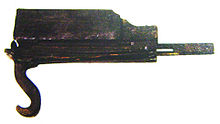
Back Чо-ко-ну BE-X-OLD Repetierarmbrust German Ballesta de repetición Spanish Chu-ko-nu Estonian Chu ko nu French Chu-Ko-Nu ID Balestra a ripetizione Italian 連弩 Japanese 연노 Korean Chu ko nu Occitan
| Repeating crossbow | |||||||||||||||||||||||
|---|---|---|---|---|---|---|---|---|---|---|---|---|---|---|---|---|---|---|---|---|---|---|---|
 The earliest extant repeating crossbow, a double-shot repeating crossbow excavated from a tomb of the State of Chu, 4th century BC | |||||||||||||||||||||||
| Traditional Chinese | 諸葛弩 | ||||||||||||||||||||||
| Simplified Chinese | 诸葛弩 | ||||||||||||||||||||||
| Literal meaning | "Zhuge [Liang] crossbow" | ||||||||||||||||||||||
| |||||||||||||||||||||||
The repeating crossbow (Chinese: 連弩; pinyin: Lián Nǔ), also known as the repeater crossbow, and the Zhuge crossbow (Chinese: 諸葛弩; pinyin: Zhūgě nǔ, also romanized Chu-ko-nu) due to its association with the Three Kingdoms-era strategist Zhuge Liang (181–234 AD), is a crossbow invented during the Warring States period in China that combined the bow spanning, bolt placing, and shooting actions into one motion.
The earliest archaeological evidence of the repeating crossbow is found in the state of Chu, but it uses a pistol grip that is different from the later and more commonly known Ming dynasty design.
Although the repeating crossbow was in use throughout most of Chinese history until the late Qing dynasty, it was generally regarded as a non-military weapon suited for women, defending households against robbers.
© MMXXIII Rich X Search. We shall prevail. All rights reserved. Rich X Search